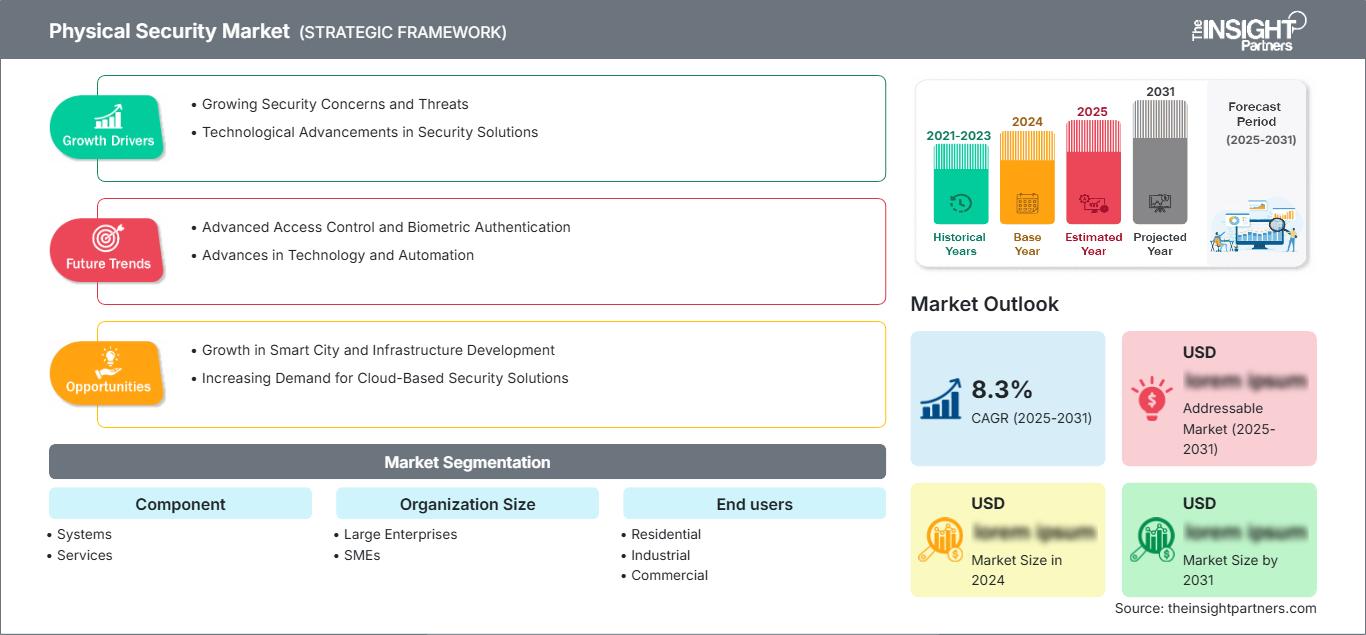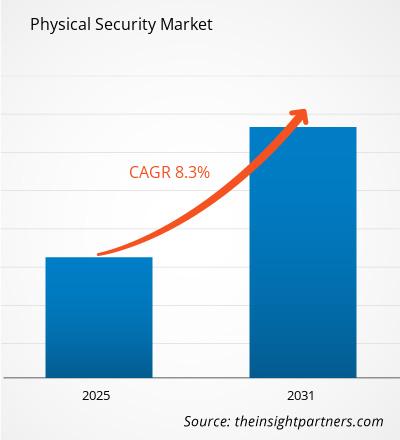Se espera que el mercado de seguridad física registre una CAGR del 8,3 % entre 2025 y 2031, y que el tamaño del mercado se expanda de US$ XX millones en 2024 a US$ XX millones en 2031.
El informe está segmentado por componente [Sistemas (Sistema de Control de Acceso Físico [PACS], Sistema de Videovigilancia, Detección y Prevención de Intrusiones Perimetrales, Gestión de Información de Seguridad Física [PSIM], Gestión de Identidad y Acceso Físico [PIAM], Seguridad contra Incendios y Vida), Servicios (Integración de Sistemas, Monitoreo Remoto, Otros)]; Tamaño de la Organización (Grandes Empresas, PyMEs); Usuarios Finales (Residencial, Industrial, Comercial). El análisis global se desglosa a nivel regional y por países principales. El informe ofrece el valor en USD para el análisis y los segmentos mencionados.
Propósito del Informe
El informe "Mercado de Seguridad Física" de The Insight Partners busca describir el panorama actual y el crecimiento futuro, los principales factores impulsores, los desafíos y las oportunidades. Esto proporcionará información a diversas partes interesadas del negocio, como:
- Proveedores/fabricantes de tecnología: Para comprender la dinámica cambiante del mercado y conocer las oportunidades potenciales de crecimiento, lo que les permitirá tomar decisiones estratégicas informadas.
- Inversores: Realizar un análisis exhaustivo de tendencias respecto a la tasa de crecimiento del mercado, las proyecciones financieras del mercado y las oportunidades que existen en toda la cadena de valor.
- Órganos reguladores: Regular las políticas y las actividades policiales en el mercado con el objetivo de minimizar el abuso, preservar la confianza de los inversores y defender la integridad y estabilidad del mercado.
Segmentación del mercado de seguridad física
Componente
- Sistemas
- Servicios
Tamaño de la organización
- Grandes empresas
- PYMES
Usuarios finales
- Residencial
- Industrial
- Comercial
Geografía
- América del norte
- Europa
- Asia-Pacífico
- América del Sur y Central
- Oriente Medio y África
Obtendrá personalización en cualquier informe, sin cargo, incluidas partes de este informe o análisis a nivel de país, paquete de datos de Excel, así como también grandes ofertas y descuentos para empresas emergentes y universidades.
Mercado de seguridad física: perspectivas estratégicas

-
Obtenga las principales tendencias clave del mercado de este informe.Esta muestra GRATUITA incluirá análisis de datos, desde tendencias del mercado hasta estimaciones y pronósticos.
Factores que impulsan el crecimiento del mercado de seguridad física
- Crecientes preocupaciones y amenazas de seguridad: La creciente preocupación por los riesgos de seguridad física, como robos, vandalismo, terrorismo y violencia en el lugar de trabajo, impulsa la demanda de soluciones de seguridad más avanzadas. Tanto el sector residencial como el comercial están invirtiendo en sistemas de seguridad física modernos, como cámaras de vigilancia, sistemas de control de acceso y detección de intrusos, para proteger los activos y garantizar la seguridad.
- Avances tecnológicos en soluciones de seguridad: La incorporación de nuevas tecnologías como la inteligencia artificial (IA), el Internet de las cosas (IoT) y el aprendizaje automático a los sistemas de seguridad física aumenta la eficiencia y la eficacia. Las empresas recurren cada vez más a cámaras de vigilancia inteligentes, sistemas automatizados de control de acceso y análisis predictivo para gestionar los riesgos de seguridad y ofrecer monitorización en tiempo real.
Tendencias futuras del mercado de seguridad física
- Control de Acceso Avanzado y Autenticación Biométrica: Las soluciones biométricas (reconocimiento facial, de iris y de huella dactilar) son cada vez más populares para el control de acceso. Al garantizar que solo las personas autorizadas puedan acceder a áreas restringidas, estos sistemas ofrecen un mayor nivel de seguridad y una alternativa más cómoda y segura a las tarjetas de acceso y los PIN convencionales.
- Avances en tecnología y automatización: El rápido avance de las tecnologías de seguridad, como la inteligencia artificial (IA), el aprendizaje automático (AA) y el Internet de las cosas (IoT), está impulsando significativamente el mercado de la seguridad física. La videovigilancia basada en IA, el reconocimiento facial y la analítica avanzada se están convirtiendo en componentes estándar de los sistemas de seguridad modernos. Por ejemplo, la videovigilancia basada en IA puede detectar anomalías o comportamientos sospechosos en tiempo real, lo que reduce la necesidad de supervisión humana constante. Además, los dispositivos conectados al IoT permiten la monitorización y el control remotos de los sistemas de seguridad, lo que mejora la comodidad y la capacidad de respuesta. Estas tecnologías están haciendo que los sistemas de seguridad física sean más inteligentes, eficientes y fáciles de gestionar, impulsando su adopción en todos los sectores.
Oportunidades del mercado de seguridad física
- Crecimiento en el desarrollo de ciudades e infraestructuras inteligentes: El desarrollo de ciudades e infraestructuras inteligentes, con énfasis en la automatización, la integración de datos y la sostenibilidad, representa una oportunidad sustancial para la industria de la seguridad física. Los sistemas de vigilancia inteligente, los controles de acceso biométricos y las plataformas de seguridad integradas pueden contribuir a mejorar la seguridad pública, las redes de transporte y la infraestructura esencial.
- Creciente demanda de soluciones de seguridad en la nube: El creciente uso de plataformas en la nube ofrece un método rentable y escalable para gestionar sistemas de seguridad física. Los sistemas de seguridad en la nube admiten monitorización remota, actualizaciones en tiempo real y almacenamiento de datos, lo que permite a las empresas aumentar la seguridad sin necesidad de equipos in situ de gran tamaño.
Perspectivas regionales del mercado de seguridad física
Los analistas de The Insight Partners han explicado detalladamente las tendencias y los factores regionales que influyen en el mercado de seguridad física durante el período de pronóstico. Esta sección también analiza los segmentos y la geografía del mercado de seguridad física en Norteamérica, Europa, Asia Pacífico, Oriente Medio y África, y Sudamérica y Centroamérica.
Alcance del informe del mercado de seguridad física
| Atributo del informe | Detalles |
|---|---|
| Tamaño del mercado en 2024 | US$ XX millones |
| Tamaño del mercado en 2031 | US$ XX millones |
| CAGR global (2025-2031) | 8,3% |
| Datos históricos | 2021-2023 |
| Período de pronóstico | 2025-2031 |
| Segmentos cubiertos |
Por componente
|
| Regiones y países cubiertos |
América del norte
|
| Líderes del mercado y perfiles de empresas clave |
|
Densidad de actores del mercado de seguridad física: comprensión de su impacto en la dinámica empresarial
El mercado de la seguridad física está creciendo rápidamente, impulsado por la creciente demanda del usuario final debido a factores como la evolución de las preferencias del consumidor, los avances tecnológicos y un mayor conocimiento de los beneficios del producto. A medida que aumenta la demanda, las empresas amplían su oferta, innovan para satisfacer las necesidades del consumidor y aprovechan las tendencias emergentes, lo que impulsa aún más el crecimiento del mercado.

- Obtenga una descripción general de los principales actores clave del mercado de seguridad física
Puntos clave de venta
- Cobertura integral: el informe cubre exhaustivamente el análisis de productos, servicios, tipos y usuarios finales del mercado de seguridad física, proporcionando un panorama holístico.
- Análisis de expertos: el informe se compila con base en el conocimiento profundo de expertos y analistas de la industria.
- Información actualizada: El informe asegura relevancia comercial debido a su cobertura de información reciente y tendencias de datos.
- Opciones de personalización: este informe se puede personalizar para satisfacer los requisitos específicos del cliente y adaptarse adecuadamente a las estrategias comerciales.
Por lo tanto, el informe de investigación sobre el mercado de seguridad física puede ayudar a descifrar y comprender el panorama de la industria y sus perspectivas de crecimiento. Si bien existen algunas preocupaciones válidas, las ventajas generales de este informe suelen superar las desventajas.
- Análisis histórico (2 años), año base, pronóstico (7 años) con CAGR
- Análisis PEST y FODA
- Tamaño del mercado, valor/volumen: global, regional y nacional
- Industria y panorama competitivo
- Conjunto de datos de Excel
Informes recientes
Informes relacionados
Testimonios
Razón para comprar
- Toma de decisiones informada
- Comprensión de la dinámica del mercado
- Análisis competitivo
- Información sobre clientes
- Pronósticos del mercado
- Mitigación de riesgos
- Planificación estratégica
- Justificación de la inversión
- Identificación de mercados emergentes
- Mejora de las estrategias de marketing
- Impulso de la eficiencia operativa
- Alineación con las tendencias regulatorias






















 Obtenga una muestra gratuita para - Mercado de seguridad física
Obtenga una muestra gratuita para - Mercado de seguridad física